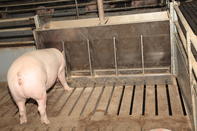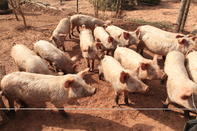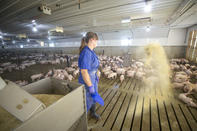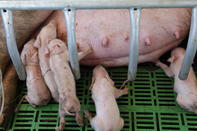For a pig farming operation to be financially viable, farmers need to secure a market for their pigs and calculate the cost of production before going into business.

If you want to open a pig farming business, you'll have to consider the cost of finance, the land, the production unit, feed, labour, medicine, the sourcing of pigs, the growth rate, the number of piglets born per litter, the number of weaners reared per sow and the number of mortalities, which are the main factors influencing the cost of production.
Start-up Costs

Starting a commercial piggery from scratch or buying it over from another farmer in South Afria can be a large financial burden. The South African Pork Producers Organisation (SAPPO) in its Pigs for Profit production manual has the following tips to keep costs low:
Farmers can start very small, with only a couple of sows, as a side-income, which will allow the farmers to learn the business before taking big financial risks.
Instead of doing rearing and growing on the farm, farmers may also reduce start-up costs and production risks by only focussing on a specific part of production. They may breed and grow weaners for a grower specialist or buy the weaners at six to ten weeks old and then raise these up to slaughter age.
Feed Costs

According to Danie Visser’s book Modern Pig Production, feed costs represents 70% to 80% of the total variable costs of production on a modern in-house commercial farm. Farmers can reduce the cost of feed by producing and mixing their own feed or sourcing cheaper food near their production unit. For example, they may source by-products from a mill or feed pods from the Prosopis tree or acorns to the pigs.
To produce their own feed, farmers would need sufficient land to do so and also consider the production cost of this, as it might require expensive production and mixing equipment.
When sourcing feed from other farmers or other businesses, farmers also need to ensure the feed is clean and does not present any health risks.
It would also help to talk to an animal nutritionist or technician to help develop a feeding regime based on the available resources and to counter possible nutrient deficiencies. Pigs will not grow well if they only have access to acorns or Prosopis pods.
The Number of Animals Sold

Profitability will largely depend on the number of animals sold, which in turn will be influenced by the number of piglets weaned per litter, the number of weaners reared per sow and the number of animals that die before they can be sold.
The number of piglets produced and weaned per sow will depend on the breed of pigs produced, whether the pigs are well fed and the production conditions.
According to Modern Pig Production, the average litter size in an intensive production system is about 11 to 12 piglets, with the best producers rearing over 28 piglets per sow per year in South Africa.
Selecting breeding material carefully can help to significantly boost the number of piglets produced and weaned per litter as well as the weight of piglets when they are born.
By Glenneis Kriel